5/22/2022
| Dr. Lisa Wild
In this article you will learn how to make your fish farming more sustainable with a few tips and tricks from the ASC certified aquaculture company FREA. There are different farming methods in aquaculture, in this specific example we will look at fish farming on land and in ponds.
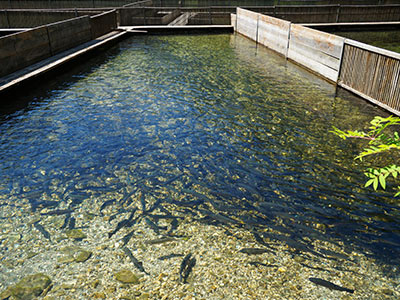
Nowadays, a healthy and sustainable lifestyle plays an increasingly important role in our society. Accordingly, the consumption of trout, which is rich in omega 3 fatty acids, has also increased dramatically. However, the demand is higher than the supply and production must double by 2030 to keep up with this demand. Therefore, aquaculture companies in turn have to make sure that as much yield as possible comes out of their aquaculture. Of great relevance is a very good water quality that needs to be monitored and controlled by high quality sensors to prevent disease and parasite spreading.
In this short article you can learn more about the background and the path of a rainbow trout from the tank to your plate and especially about the question how fish can be farmed more sustainably.
The world is hungry for fish
Coming from a healthy ecosystem, fish is considered a very good source of protein, but our ecosystem is critically endangered: Oceans are overfished and fish may be contaminated with heavy metals that have accumulated in the larger species, fish from aquacultures may be treated with antibiotics to control disease outbreaks and in open water aquacultures feces of fish pollute the sea or lakes and endanger the ecosystems immensely. However, fish from aquacultures can be sustainable and healthy when certain criteria is met.
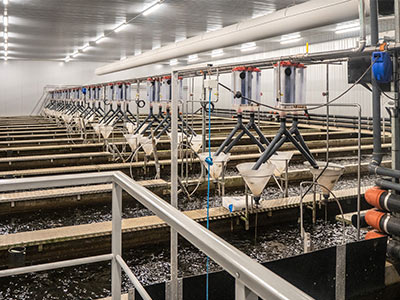
The aquaculture fish market is growing and demand can only be met when fisheries work as effectively and sustainably as possible. One of the main obstacles to high quality, clean rainbow trout production is the high susceptibility of rainbow trout to sea lice and this is one of the most concerning factors hindering rapid growth of the rainbow trout market . To reduce the risk of parasite outbreak, good water quality monitoring and a well working circular freshwater system are for instance required. To guide and support fish farm owners, the European Commission has recently adopted strategic guidelines for sustainable and competitive aquaculture in the EU.
The Guidelines have been developed in consultation with EU Member States and stakeholders, in particular in the framework of the Aquaculture Advisory Council.
They defined four interrelated objectives for the further development of aquaculture in the Union:
- Build resilience and competitiveness
- Contribute to the green transition
- Ensure social acceptance and consumer information
- Promote knowledge and innovation
The proposed guidelines will also promote the comprehensive expansion of organic aquaculture at the EU level. As outlined in the recently published Action Plan to Promote Organic Production, organic aquaculture remains a relatively new sector, but one with significant growth potential.
These guidelines are a first step towards a more sustainable way of fish farming and consumption. A great example for such a sustainable fish farm is the aquaculture company FREA A/S. They breed 25 million rainbow trout a year in two large halls of 4,000 square meters each on a field in Central Jutland (Denmark) far from lakes or large streams.With their experience and example plant, we have identified the following 5 steps with which you can make your fish farm more sustainable and ready for the future.
Tips and tricks from our experts
The path to sustainable aquaculture and healthy fish
1) Recycling Water to achieve a Circular Economy
As drinking water is becoming scarcer every day, it is important to not waste any water and recycle as much water as possible. The groundwater must first be extracted, filtered, purified and oxygenated before being used in the aquaculture process. Therefore the main parameters pH and DO must be monitored to ensure optimal water quality for the fish. In a circular economy there is no direct discharge to the aquatic environment. Prevalent particles are removed from the water using bio filters and are being fermented for later use as fertilizer or fuel in biogas plants. The runoff water is channeled into large infiltration basins and later reused for production.
2) Water Quality Monitoring in aquaculture - Measurement of the most important parameters such as pH and oxygen
One of the most important parameters for fish farming is oxygen. Sufficient oxygen is necessary
for the fish to transform feed into energy (see also step 4). Each fish species has its preferred oxygen levels—and dissolved oxygen concentrations below their welfare and tolerance limits result in lower yields. With the FDO® 700 IQ we could offer the FREA plant a calibration-free Oxygen sensor, which they placed in each of the 86 basins. The FDO sensors can be used to regulate the addition of oxygen individually via the PLC control system to provide the optimal oxygen concentration and at the same time reduce costs with no oversaturation.
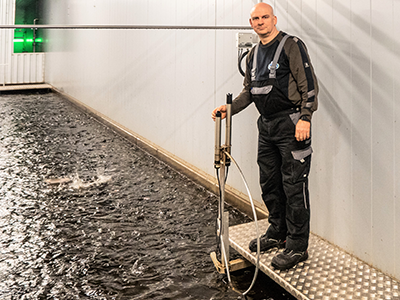
We are proud that Xylem Analytics Germany was able to equip the FREA-Aquaculture with pH and DO-sensors of our WTW brand. Moreover, FREA A/S installed twelve digital pH sensors of the type SensoLyt® 700 IQ, which have been proven to be remarkably resistant to fouling. How our sensors have been applied in rainbow trout farming in Denmark you can download an application note for free.
3) Prevention of disease outbreaks by subdividing the plant
To prevent the spreading of infection, it is beneficial to divide the plant into different sections, such as hatcheries, facilities for juvenile fish and for portion fish. In the FREA plant, there is within the individual plants an additional sectioning, which overall creates a significant reduction in risk for extensive disease outbreaks and the spread of infection. During the process, fish are sorted by size and vaccinated against rubella, which is fatal to the fish.
4) Fish Nutrition
To make fish farming as sustainable and economic as possible, it is very important to maximize the feed to fish ratio. The fish’s feed mainly consists of protein and fat, which allows to turn as much as possible of the feed into fish. The FREA plant has achieved that approximately 900 grams of feed is converted to 1,000 grams of fish, which is such great value thinking of the 25 kg feed needed to produce 1 kg of beef.
5) Controlling waste products/ Fish farming water treatment
Certainly there is always some waste in fish farming. Feed that is not turned into the growth of fish but into feces in the form of nitrogen is about 35 grams per kilogram growth. This nitrogen input makes it necessary to purify the process water for subsequent recycling. The removal of nitrogen from the water is accomplished in biological nitrogen filters. Subsequently pure oxygen from an oxygen tank is added.
Certainly there are more steps and things to consider in a fish farm, but the 5 steps described above will lead to a sustainable and effective fish farm. Most importantly, continuous water quality monitoring should not be neglected even after a facility is approved and operational. Real-time data helps farm managers keep their fish healthy and can lead to significant savings for farm owners.
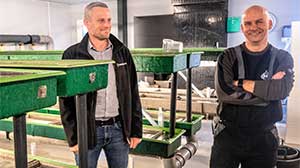
The WTW instruments have fully met our expectations: They are very user-friendly and the installation was simply "plug & play".

With these 5 steps, you can not only improve the efficiency and quality of onshore fish farming, but also reduce the environmental footprint of fish production. If as many aquaculture farms as possible apply these steps together with the new strategic guidelines for sustainable and competitive aquaculture in the EU for their fish farms, it is possible that our daily fish can be produced in a more environmentally friendly and sustainable way and the increasing demand for aquaculture fish can be met.
Avoid fish diseases with high quality measurement technology!
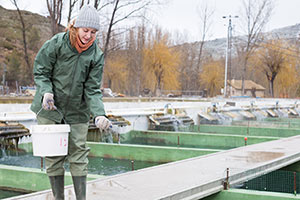 There is a concrete application example in which we provide you with our expert knowledge as a how-to, so that you can learn at a glance how our products contribute to the health of your fish and thereby also achieve a higher yield of trout.
There is a concrete application example in which we provide you with our expert knowledge as a how-to, so that you can learn at a glance how our products contribute to the health of your fish and thereby also achieve a higher yield of trout.

References:
https://www.factmr.com/report/2084/rainbow-trout-market
https://ec.europa.eu/commission/presscorner/detail/de/IP_21_1554
Livestock conversion efficiencies are given as reported in Alexander et al. (2016). Alexander, P., Brown, C., Arneth, A., Finnigan, J., & Rounsevell, M. D. (2016). Human appropriation of land for food: the role of diet. Global Environmental Change, 41, 88-98.
https://ec.europa.eu/commission/presscorner/detail/de/IP_21_1554
https://www.xylemanalytics.com/en/applications/aquaculture
https://www.xylemanalytics.com/File%20Library/Resource%20Library/WTW/09%20Application%20Papers/WTW-A202101-FREA-Fish-Farm-Denmark.pdf
IQ pH/ORP armatures - WTW (xylemanalytics.com)
https://www.xylemanalytics.com/en/general-product/id-147/IQ-pH-Redox-Armaturen---WTW